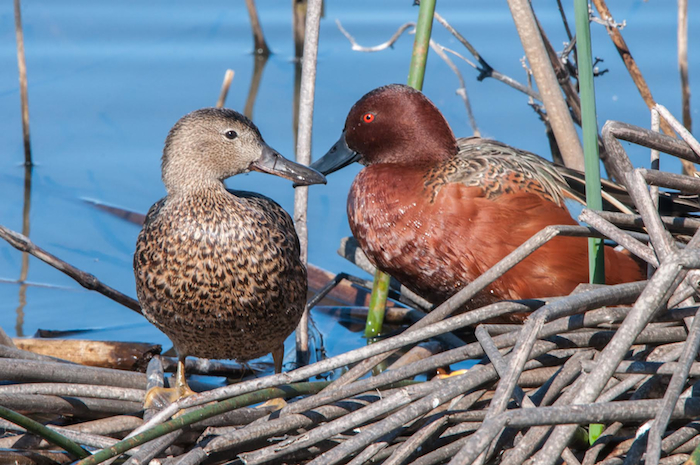
Cinnamon Teal Pair
Since water is fundamental to all life on Earth, rivers create particularly desirable ecosystems for people and many other species. In Redding, it makes for good bird-watching right here in town.
At Turtle Bay the Sacramento River offers an especially prosperous riparian habitat. Along the Sundial stretch the river runs briskly, with gravel bars that riffle the water, oxygenating it, supporting abundant aquatic insect life. These insects become food for salmon, trout and other fish that in turn feed ospreys and cormorants, gulls, turkey vultures, kingfishers, fish-eating ducks such as mergansers, several species of grebes, and of course our famous eagles.
Many birds bypass the fish and eat the bugs directly. In winter, ducks from the high arctic and the Great Plains pothole country—golden-eyes, buffleheads, and ruddy ducks—along with the more local wood ducks and occasional scoters sheltering inland from the stormy ocean—gather for the Good Life of clean water and plenty of insects and snails. In spring, prolific hatches of aquatic insects provide food not just in the water but over it, protein and calories for cliff swallows up from South America, who nest colonially under the bridges and snatch winged breakfast for both themselves and their young.
Downriver, around the bend, the riverflow is broken into quieter bays and side channels that offer resting places for numerous species. There, along with Canada geese, more ducks of winter—mallards, gadwall, ring-necked ducks, and sometimes teal, shovelers, pintails, and canvasbacks—nibble at the pond plants, fattening up for the next spring’s long flights and nesting season.
Wading birds hunt the shorelines year round. Great blue herons, egrets, killdeer, yellowlegs, snipe, and spotted sandpipers stalk and snatch fish and invertebrates at the water’s edge.
Brush along the banks and around river backwaters provides homes for song sparrows, bushtits, and towhees, and vital feeding corridors for migrating warblers.
Above the brush, cottonwood trees create a spreading canopy for nesting and feeding. This riparian wood, especially in dead trees, is soft, so Nuttall’s and Downy woodpeckers readily excavate numerous nesting cavities, used in spring by bluebirds, titmice, nuthatches, wrens, tree swallows, and ash-throated flycatchers. The trees’ leafy twig-ends can hold the rocking cradles of orioles. Heavier branches form the foundations for robin nests, not to mention osprey and eagle eyries.
The Turtle Bay cliffs offer nesting to a pair of peregrine falcons, and merlins will appropriate the nests of other birds. These predators can prosper because the smaller birds they eat are so abundant.
It’s a rich little jewel, here in the heart of town, a gem connected to others by the flowing river that makes it all possible.
Wintu Audubon offers walks at Turtle Bay on the first Saturday of every month, meeting at 9am at the concrete monolith.

Comments are closed.